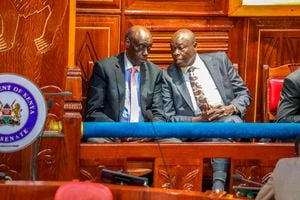Hang up now if you know what African beauty is
FOR MANY YEARS, I NEVER paid much attention or got involved in debates about race, partly because there is a great deal of futility about it. I am black, you are white. We get along in multiracial harmony, or we don’t because of racist prejudice.
Whatever the case, there is one thing neither of us can change: I will always be black, and you will always be white.
Well, that was until both the world’s and Africa’s views about black people began to change in ways I wouldn’t have foreseen in my young, radical days.
DStv is advertising the Face of Africa contest for 2009, and as a prelude, it showed the 2008 contest. I happened to come into a TV room when some two young ladies were watching it, and the show was nearing the end.
I asked who they thought was going to win, and in chorus, they said: ‘‘the ugliest one’’. And so it was that Ghana’s Kate Menson was declared the winner.
What a change! It seems to have started with the troubled black British Naomi Campbell — tall, very dark, truly full lips, and all. Then followed the more likeable and brilliant south Sudanese Alek Wek — even darker than Campbell, with short cow-pea hair. As the brothers say, ‘‘We’ve come a long way, baby’’.
Times were when, at least internationally, the model of African beauty was someone like Uganda’s Princess Elizabeth Bagaya, or the Somali supermodel, Iman — light-skinned, aquiline, long hair, the works.
The swing to the extreme end where Wek is the big thing has come with the global growth of what you might call the ‘‘ethnic cultural market’’ that has been set off by many forces — globalisation, the Internet that allowed many alternative cultural narratives to find an international airing, and, ironically, the rise of the anti-globalisation movement that gave rise to ethnic and fair trade.
Thus today, of all things, decorative baskets made by Rwanda genocide survivors can be on sale in fashionable stores like Macy’s in New York.
In July last year, Vogue published a so-called ‘‘black issue’’ — featuring several of the world’s top black models. Because the beauty and fashion industry has an anti-black thing, it was expected that the issue would flop. Wrong. Instead, Vogue went into reprint as it became one of the most successful issues ever!
However, the overall trend of what you might call ‘‘making black blacker’’ has not sorted out the problem of accurate representation of blackness. Thus, if one goes by the Face of Africa programme I saw, the finalists do not represent anything close to the wide range of the faces of African women.
I WILL NOT SWEAT THE ISSUE OF thinness here. As the writer David Rubadiri is reputed to have said, African women are not African women ‘‘if they have nothing to hold’’ on them.
The bigger issue is that African women look both like Wek, and like Iman. There are Creoles along the southern African and West African coasts; there are the Swahili ones along the Eastern African coast, and the Arabic ones in North Africa. In countries like South Africa, they are white, and in an endless array of diversities in the vast hinterland.
It could well be that the problem with trying to define blackness, or Africanness, is that you are dealing with 1,000 possibilities, whereas defining whiteness is to deal with 10 possibilities. An ‘‘ethnic look’’ is a fallacy.
What is easier is knowing when an injustice has been committed against people of colour as the US publishers Bloomsbury Children’s Books did recently.
Justine Larbalestier (you would know her if you have book-loving teenage children) has a new book out called Liar.
The book, according to a review in The Independent, is a story about an African-American girl, Micah, with short ‘‘nappy’’ hair.
However, Bloomsbury sent out review copies of Liar featuring a picture of a white girl with long, straight hair. It ran into a big wave of outrage, and has been pilloried on the Internet.
Larbalestier, too, is chafed. Said she: ‘‘The ‘whitewashing’ of book covers is a long-standing industry problem. The use of cover shots of white people, the ‘ghettorising’ of books by people of colour, and low expectations [reflected in the lack of marketing push behind the majority of those books] are not new things’’, she is quoted as telling Publishers Weekly.
Not quite a Cinderella ending, but in October, Bloomsbury is issuing a hardcover edition of Liar with a picture of a black girl. The girl, well, she looks more like Iman than Wek.





